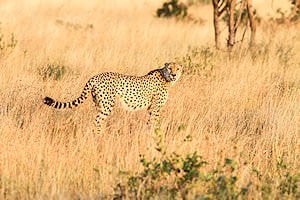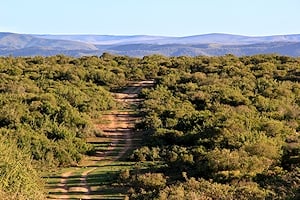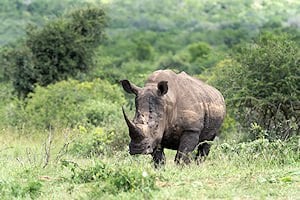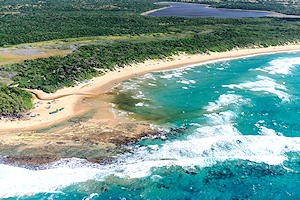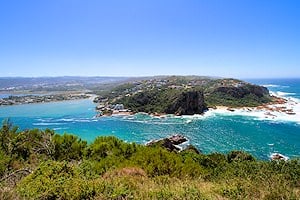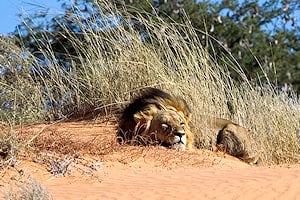- USD
- EUR
- GBP
- AUD
- CAD
- ZAR
The Camdeboo National Park stretches across 19 405 hectares. It is a unique safari destination in South Africa that surrounds Graaff-Reinet. The region, known as the "Valley Of Desolation," is the most popular attraction in the national park. African Sky could include a visit to Camdeboo in a custom safari or private tour itinerary.
Need Advice?Some people refer to the Valley of Desolation, Camdeboo's primary attraction, as the 'Cathedral of the Mountains.' It provides a spiritual experience for many visitors who are moved by the eerie silence and the uniquely stark beauty of the landscape.

Camdeboo National Park offers several walking trails, ranging from walks that last an hour to extended hikes where overnight camping is required. Forty-three mammal species occur in the park. Visitors can see steenbok, black wildebeest, and blesbok when driving in the more open areas. Animals that enjoy the thickets include the kudu and grey duiker. The Cape buffalo and mountain zebra are rarely spotted, but red hartebeest and gemsbok sightings are a near certainty.
We stare ardently at artificial structures such as the Colosseum (48m high), the Statue of Liberty (46m high), and the famous soapstone Christ the Redeemer (38m high) looking over Rio de Janeiro in Brazil. Still, nature is the ultimate builder, sculptor, and artist. The dolerite pillars that reach heights of 90 to 120 meters in the park leave visitors feeling overwhelmed and humbled.
The dolerite pillars in the famous Valley of Desolation are a geographical wonder that is millions of years old. The magnificent volcanic, corrosive handiwork of Mother Nature is abundantly clear when the sheer cliffs and rock formations are viewed from the park's many scenic routes and picnic sites.
It is not what you would expect from a park set in the middle of the Karoo, but the plains at the foot of the Sneeuberg Mountains are paired perfectly with the Nqweba Dam. Various animal, bird, reptile, and even fish species are found in the area. To top it off, a diverse range of plants and flowers add many colors to the expanse.
Savor the silence and solitude and watch for wildlife you may usually overlook in more game-viewing-oriented parks.
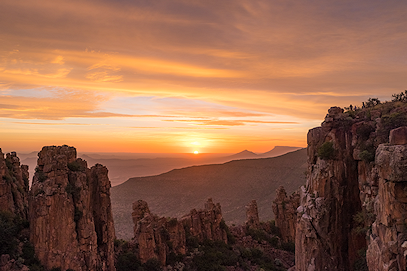
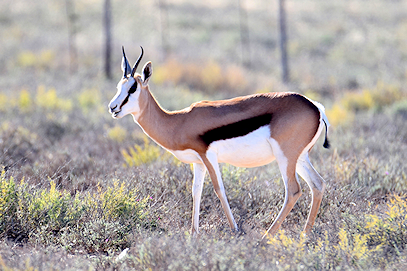
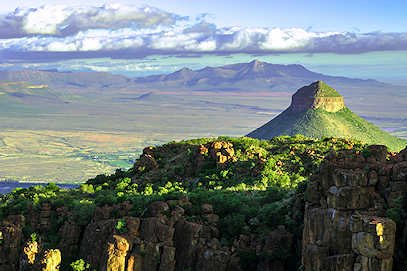
George and Port Elizabeth airports are easily accessible from all major airports in South Africa, and daily flights are also available between the two. The departure point to the Camdeboo National Park will vary depending on your specific combination of destinations. However, the preferred final flight destination is Port Elizabeth because it is closest to the park.
It is approximately 353km from George Airport and 250km from Port Elizabeth Airport. Visitors to the park are transported via private, air-conditioned vehicles from one of the above airports, depending on their package.
The Camdeboo National Park is in the eastern parts of the Great Karoo, which experiences rainfall predominantly in the spring and summer seasons, often accompanied by thunderstorms and high temperatures. The winters are cold; snow can sometimes be seen higher up in the mountains.
It is best to visit the park in spring or early summer, from August to November, when the wildflowers bloom, and the newborn antelope can be seen amongst the herds grazing on the shrubland. However, it can get scorching; you should limit strenuous activities such as hiking too early mornings or late afternoons.
Graaff Reinet is the fourth-oldest town in South Africa. Founded in 1786 and built on the banks of the Sundays River, its cultural and historical attributes, such as the Dutch Reformed Church and the Reinet House Museum, attract multitudes of visitors throughout the year. The Camdeboo National Park, previously known as the Karoo Nature Reserve, surrounds the old town. The Karoo Nature Reserve was established in 1979 when various private landowners and the World Wildlife Fund in South Africa recognized the need to conserve the Karoo biome.
The area's history, however, stretches millennia. It is geologically and archaeologically rich, from the obscure dolerite pillars to prehistoric fossils. It is almost impossible to grasp the natural abundance in what some – mistakenly – think of as barren lands. There is evidence of Stone Age dwellers in the park along the Sundays River to the Eastern Cape coast. The nomadic people created rock paintings and shelters and used various tools for hunting, fishing, and wild food harvests.
You will find well-adapted animal groups in the Camdeboo National Park. It is necessary because the Karoo becomes extremely dry, and conditions are unpredictable. The 43 mammal species include antelope like springbok and kudu, lesser mammals like vervet monkeys and meerkats, and rodents and carnivores like the bat-eared fox. Amphibians are also endemic to the area, and various frog, lizard, tortoise, and snake species can be found. The reptiles live all over the park but seldom come out during the day's heat, preferring the shady crevices of the rock formations for some relief from the high temperatures.
Two hundred fifty bird species have been documented in the area, one of which is the ostrich, which adapted perfectly to the Karoo environment. Birds in the area include storks, rock kestrel, Diederik cuckoo, brown-hooded kingfisher, Namaqua dove, cardinal woodpecker, speckled mouse bird, long-billed crombec, and ant-eating chat. Various hawk and eagle species, including the black eagle, have been spotted, and an assortment of water birds, like the flamingo, can be seen in spring and summer. The Nqweba Dam also hosts a lot of fish and is an attraction for many birds and birders.
The Karoo is very dry but is referred to as a semidesert environment due to its annual precipitation. The plant types vary from season to season, and the unpredictable weather patterns and diverse altitudes add to the fluctuations in biodiversity. There is Shrubland at higher altitudes and grassland in the valleys. The other dominant vegetation type found in the park is the succulent thicket which, as is evident from its name, encompasses various succulents, which includes the aloe genera.
The park is dominated by geological anomalies resulting from over a hundred million years of volcanic and erosive events. It is famous for its natural wonders, like the dolerite pillars and sheer cliffs found in the Valley of Desolation, as well as the strangely shaped mountains, such as Spandoukop, that form part of the silhouette of the Karoo.
The expansive and naturally diverse landscape of the Camdeboo National Park offers visitors a wide range of activities. It is every landscape photographer's or cinematographer's dream. You can capture epic footage from wherever you find yourself in the park. A drive or hike up to the Valley of Desolation is a perfect way to explore the park and get a bird's eye view of the panoramic setting. The various day and overnight hiking trails also make for excellent wildlife viewing.
Bird watching is outstanding, especially at the Nqweba Dam. The Graaff Reinet Birding Club is a regular visitor to the park. The Nqweba Dam allows for various water-based activities, such as fishing, boating, canoeing, skiing, and even windsurfing (weather permitting). There are two 4x4 trails of varying difficulty in the park.





This website uses cookies. To learn more about how we use cookies, please view our Privacy Policy. By clicking "I Accept" on this banner, you consent to the use of cookies unless you have disabled them.
